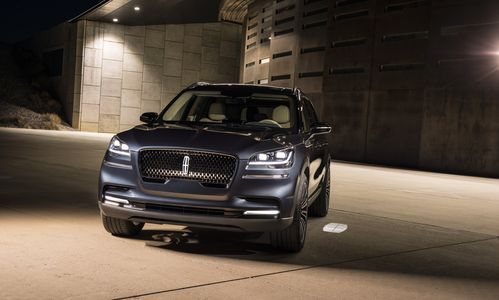Autoplay
Show Thumbnails
Show Captions

2019 Lincoln Aviator
(Photo: Lincoln)
Lincoln Motor Co.’s next act begins with an all-new three-row, rear-wheel drive SUV aimed at the heart of the premium market.
The Blue Oval’s luxury brand is bringing back the Aviator in 2019. It could continue the momentum built by the behemoth Navigator launched last year — and that’s exactly what Ford and Lincoln executives want from the Explorer-sized luxury SUV.
The pre-production utility vehicle debuting Wednesday at the New York auto show has spacious interior design cues seen in the full-size Navigator SUV. But Lincoln design director David Woodhouse and his crew gave the Aviator an exterior inspired by airplane wings and in-flight birds.
The result is a strikingly different Lincoln SUV. It’s sleek, commanding, reminiscent of other popular three-row luxury utes, yet unique in its sharp angles, tapered body and beefy front end. Industry experts say it’s a good start for the first of six all-new SUVs scheduled to debut over the next few years.
“It’s really pretty,” Stephanie Brinley, analyst with IHS Markit, said. “It shows there’s more to build from (and) Continental and Navigator weren’t one-offs. The Lincoln design is repeatable, it’s executable. They’ve really done a spectacular job at bringing something fresh and dynamic to a space where it’s difficult to do that.”
Joy Falotico, the newly appointed Lincoln president, said in a Detroit News interview, “Consumers will be surprised. This embodies the plan we have to go forward with the brand.”
The new Aviator won’t be so much a gamble as it will be a necessity for the luxury carmaker that’s been rebranding itself for the last four years.
It fills in a gap in Lincoln’s lineup. As U.S. and Chinese consumers opt for larger vehicles, Falotico expects the luxury SUV market to grow 20 percent by 2020; the segment saw sales of more than 585,000 units in 2017. Lincoln currently has two smaller SUVs — the MKC and recently renamed Nautilus, which mirror the Ford Escape and Edge, respectively — and the massive Navigator. The Aviator will add a three-row vehicle that’s smaller than the Navigator, but still big enough for younger families, Falotico said.
“The Navigator’s just too big for some people,” she said.
The new vehicle will launch in 2019 with a plug-in hybrid option under Ford Motor Co.’s new product guidelines: more SUVS, more hybrids, all built on one of five “flexible architectures.” One of those architectures is the rear-wheel drive unibody design the Aviator will be built on.
Lincoln only said a standard twin-turbocharged powertrain can be paired with the brand’s first plug-in hybrid technology. Other engine specs — including expected fuel economy — were not released. Lincoln has not said how much the Aviator will cost.
The pre-production model looks close to what the actual vehicle will look like when it begins hitting showrooms next year, according to spokeswoman Angie Kozleski. The new SUV gets an upright honeycomb grille and a fatter front end that contrasts with the sloping design on the Continental or Navigator.
Woodhouse and his team designed the Aviator to look graceful and powerful. And the design team’s work both inside and on the body of the vehicle is vital in the luxury segment, industry analysts said. Luxury vehicles come standard with tons of technology features and premium interior materials, so flashy perks won’t net new customers.
An eye-catching design could bring in droves of the 35- to 44-year-old millennial market Lincoln and other automakers covet. The Aviator will debut with a roomy interior and center console design that debuted on the Navigator, which has been a selling point for the full-size SUV.
Karl Brauer, an analyst with Cox Automotive, said the Aviator builds on the exact thing that has driven up Navigator sales — and Lincoln’s average transaction price — since the vehicle launched.
“For all intents and purposes, it’s going to be Navigator, part two, and that’s not a bad thing,” he said. “It has attractiveness inside and out, and that’s what a luxury vehicle in the 21st century lives and dies on.”
The Aviator embodies a new Lincoln, Brauer said. Or, at least a Lincoln Motor Co. that’s remembering where it came from.
“We’re seeing them stop trying to be an American version of European luxury,” he said. “Just start being American luxury again. (Lincoln vehicles have started) to become more robust American names and robust American styling and robust American driving capability.”
The Aviator will have Lincoln’s full suite of convenience features and services the company has been building over the last three years. One new perk is Lincoln’s Suspension Preview technology, which adjusts suspension as a forward-facing camera reads the roads to reduce stress on the vehicle from potholes or bumps.
The vehicle will also come with Co-Pilot360, a suite of standard safety and driver assist features Ford is putting on all its new vehicles.
For now, the SUV gives consumers and investors a taste of what Lincoln executives say the company has going for it.
“We feel momentum, and we think it will translate,” Falotico said. “I think the Aviator will continue that. We’re really focused on continuing the momentum, and on the growth of the company.”
ithibodeau@detroitnews.com
Twitter: @Ian_Thibodeau
Read or Share this story: https://detne.ws/2I9ydaK
